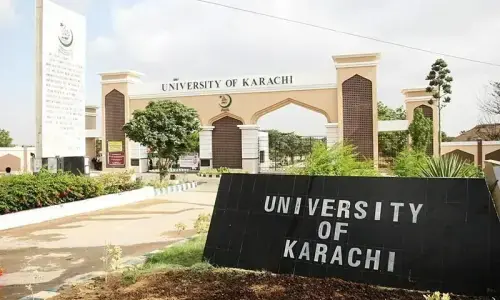KARACHI: Pakistan has a 1,046-km-long coastline that stretches along the border of the Arabian Sea. The Sindh coastline is about 320km long, and runs along Sir Creek on the east to Hub River on the west. The coastline of Karachi is about 70km long, and is located between Cape Monze and Korangi Creek.
Sea levels are rising at a significant rate because of global warming caused by carbon dioxide and other gases being released into the atmosphere in large quantities. Melting of glaciers, the heating and expansion of oceans and the melting of the Antarctic ice caps are contributing to sea level rise (SLR).
Some studies project sea levels to rise by 60 centimetres, or two feet, by 2050 and 110cm (3.6 feet) by 2100. SLR projection is influenced by subsidence, oceanographic effects and mass balance changes with the ice sheets.
According to Nasa’s climate change website, the global rate of change of sea level is 3.3 millimetres (mm) per year and the sea level increased by 240mm (nearly 10 inches) from about 1870 to 2019.
According to the US National Oceanic and Atmospheric Administration, the global sea level has been rising over the past century, and the rate has increased in recent decades. In 2014, global sea level was 2.6 inches above the 1993 average. Sea level continues to rise at a rate of about one-eighth of an inch per year.
Measures can include building of seawalls, dykes, restoration of mangroves, reefs and wetlands
There are large uncertainties in sea level projections. According to some researchers, the SLR projection for Karachi for 95 percentile, is 2.6 metres (8.5 feet), relatively to the level in 2000, by 2100.
A 2019 report of the Intergovernmental Panel on Climate Change on the Ocean and Cryosphere in a Changing Climate indicates global SLR of 1.1m (3.6ft) by 2100, after including Greenland and Antarctica ice sheets’ mass loss.
Global sea differs from local sea level. Global sea level trends and relative sea level trends are different measurements. Just as the surface of the Earth is not flat, the surface of the ocean is also not flat — in other words, the sea surface is not changing at the same rate globally. Sea level rise at specific locations may be more or less than the global average due to many local factors: subsidence, upstream flood control, erosion, regional ocean currents, variations in land height, and whether the land is still rebounding from the compressive weight of Ice Age glaciers.
Eight of the 10 big cities of world near a coast
Globally, eight of the world’s 10 largest cities are near a coast. The Global Risk Report 2019 says: “Around 90 per cent of all coastal areas will be affected to varying degrees. Some cities will experience sea-level rises as high as 30 per cent above the global mean. Making matters worse, sprawling cities are sinking at the same time as sea waters seep in. This is due to the sheer weight of growing cities, combined with the groundwater extracted by their residents.”
In Karachi, the average mean sea level rose to 1.1mm per year. The land subsidence rates in the Indus delta is around 4mm per year.
According to a report, the Arabian Sea has intruded up to 67 km, destroying large swathes of agricultural land in Thatta and Badin districts by turning it saline. More than 3.1 million acres of agricultural land has been submerged in Badin, Thatta and Sujawal districts.
Major factors that contribute to SLR are thermal expansion of seawater, caused due to greenhouse gas (GHG) emissions — in case of Karachi, coal-fired power plants are main culprits in releasing GHGs — and melting of the ice sheets. Melting of Greenland and Antarctica glaciers will increase the sea level by a whooping seven metrrs (23ft). This will inundate about 50pc area of Karachi.
Resilience strategy for Karachi needed
In Karachi, the Sindh planning and development (P&D) department is responsible for preparing strategies and development plans. Alongside mitigating the carbon footprints through reducing emissions, it should develop a resilience strategy for Karachi. Many cities like Bangkok, Los Angeles, New York, Amman, Melbourne, etc, have prepared resilience strategies.
The resilience strategy represents preparedness, addressing emerging resilience challenges and embedding resilience into a city’s operations and systems. Many cities have already started building on the strategies, and translating the plans into actions.
Karachi can take a number of actions to deal with SLR. These include (a) hard engineering projects like seawalls, surge barriers, dykes, breakwaters, barriers and barrages to protect against water intrusion; (b) adopting environmental approaches, like restoration of mangroves, reefs and wetlands; (c) employing soft structures, like beach and shore strengthening; and (d) people-oriented measures including urban design, building resilience and retreating (migration, displacement and relocation).
One can also learn from what other cities are doing. For example, London has the Thames Barrier, designed in the 1970s for future repeats of the 1953 meteorological storm surge in the North Sea. The Thames Barrier has been closed 184 times since it became operational in 1982. Of these closures, 97 were to protect against tidal flooding and 87 were to protect against combined tidal/fluvial flooding.
Dutch coastal cities have bolstered by hard defences including a 3,700km network of dykes, dams and seawalls, including the famous Maeslant Barrier. Rotterdam offers a model for how to manage sea-level rise. The city is 90pc below sea level. Cities like Rotterdam are converting ponds, garages, parks and plazas into part-time reservoirs. They are also revitalising neighbourhoods and improving equity to build social resilience to future water threats.
Cities bolstering resistance to rising sea levels
China and Vietnam have launched ‘sponge city’ initiative. The sponge city is more like a sponge; it actually absorbs rainwater, which is then naturally filtered by the soil and allowed to reach into the urban aquifers. This allows for the extraction of water from the ground through urban or peri-urban wells. This water can be easily treated and used for the city water supply.
Shanghai has constructed 520km of protective seawalls that stretch across the Hangzhou Bay and encircle the islands of Chongming, Hengsha and Changxing. As in the case of Rotterdam, Shanghai has also installed massive mechanical gates to regulate overflowing rivers.
Bangkok has also laid out a 2,600km canal network and central park with a capacity to drain 4m litres into underground containers.
Jakarta is building a massive sea wall with Dutch support, and is planning to relocate 400,000 people from threatened riverbanks and reservoirs.
American cities are investing billions of dollars to bolster their resistance to rising sea levels. New Orleans established the Hurricane and Storm Damage Risk Reduction System shortly after Hurricane Katrina killed more than 1,600 people in 2005, leaving 80pc of the city underwater. The system includes a series of massive dam barriers, reinforced levees and flood walls stretching some 560km around the city. The city also built a living water system of parks, wetlands and other existing features to reduce reliance on pumping and canals. It is one of the largest public works projects in US history and the most expensive flood-control system in the world. Boston, Houston, Miami, and New York City also have similar plans.
—The writer has a master’s degree in environmental engineering from the Asian Institute of Technology, Bangkok
Published in Dawn, April 30th, 2020


































